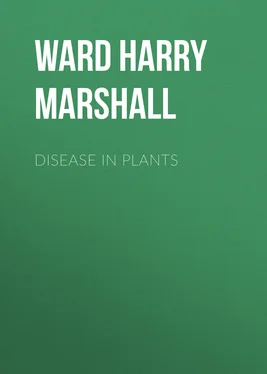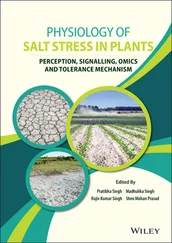Harry Ward - Disease in Plants
Здесь есть возможность читать онлайн «Harry Ward - Disease in Plants» — ознакомительный отрывок электронной книги совершенно бесплатно, а после прочтения отрывка купить полную версию. В некоторых случаях можно слушать аудио, скачать через торрент в формате fb2 и присутствует краткое содержание. Жанр: foreign_prose, Биология, Биология, foreign_edu, foreign_antique, на английском языке. Описание произведения, (предисловие) а так же отзывы посетителей доступны на портале библиотеки ЛибКат.
- Название:Disease in Plants
- Автор:
- Жанр:
- Год:неизвестен
- ISBN:нет данных
- Рейтинг книги:5 / 5. Голосов: 1
-
Избранное:Добавить в избранное
- Отзывы:
-
Ваша оценка:
- 100
- 1
- 2
- 3
- 4
- 5
Disease in Plants: краткое содержание, описание и аннотация
Предлагаем к чтению аннотацию, описание, краткое содержание или предисловие (зависит от того, что написал сам автор книги «Disease in Plants»). Если вы не нашли необходимую информацию о книге — напишите в комментариях, мы постараемся отыскать её.
Disease in Plants — читать онлайн ознакомительный отрывок
Ниже представлен текст книги, разбитый по страницам. Система сохранения места последней прочитанной страницы, позволяет с удобством читать онлайн бесплатно книгу «Disease in Plants», без необходимости каждый раз заново искать на чём Вы остановились. Поставьте закладку, и сможете в любой момент перейти на страницу, на которой закончили чтение.
Интервал:
Закладка:
Notes on Chapter V
For the further pursuit of this subject the reader should consult Sachs' Lectures , II. and XV.; Sorauer, A Popular Treatise on the Physiology of Plants , 1895, chapters II. and IV., and Pfeffer's Physiology , pp. 149-163. The principal paper on root-hairs referred to in the text is Schwarz, "Die Wurzelhaare der Pflanzen," in Unters. aus dem bot. Inst. zu Würzburg , I. Heft 2, 1883, p. 140, where a very exhaustive account of these organs will be found.
CHAPTER VI.
THE FUNCTIONS OF ROOT-HAIRS
Excretions from root-hairs—Osmotic phenomena—Turgescence—Plasmolysis—Control of the protoplasm in absorption, etc. Selective absorption.
We see then that the root-hairs are the active living instruments in absorbing the water (containing small quantities of dissolved substances) of the soil.
If the living root-hairs are so numerous and so active, however, a natural inference is that they must exert some influence on the composition or arrangement of their environment. All the teachings of modern physiology go to show that such a living cell as I have sketched cannot carry on its life, brief though it be—the root-hairs are active for about four or five days—without forming substances of the nature of excreta, and we should expect some of these to pass out to the soil.
Sachs showed, in 1860, that roots growing in contact with polished marble corrode the surface of the mineral, and Nobbe, in 1876, showed that the roots of seedlings reduce potassium permanganate, a fact which Molisch confirmed in 1887. The latter observer also proved that living root-hairs secrete substances which colour a solution of guaiacum blue, oxidise pyrogallic acid and other organic substances, and rendered it probable that they excrete some substance which inverts cane-sugar, and in some cases even small quantities of a diastatic enzyme.
Molisch also confirmed an old observation, that roots excrete carbon-dioxide; and he and Czapek showed that the root-hairs excrete acids more permanent in their nature than carbonic acid, and published a method for showing this by means of a dilute solution, slightly alkaline, of phenolphthalein.
Molisch declared that the substances secreted by root-hairs may even be observed, dissolved in drops which ooze from the surfaces of the root-hairs.
That these root-excretions, and particularly the acids, may be of service in dissolving and rendering more available various constituents of the soil is an obvious suggestion, and it is borne out by Sachs' discovery of the corrosion of marble, and by Molisch's observation that living roots slowly corrode ivory if continuously kept in contact with it.
But a deeper insight into the physiology of these organs was only possible when the meaning of the phenomena of osmosis had been rendered clearer by the researches of Pfeffer and De Vries in 1877.
De Vries showed that the turgescence of the living cell can be diminished, and even reduced to nothing, by placing the cell in contact with solutions of substances which attract water from the cell-sap: as the turgescence diminishes, the cell contracts, owing to the elasticity of the cell-wall, which was previously distended; if the abstraction of water continues, the living protoplasmic membrane lining the cell-wall contracts away from the latter. He then proved that no injury need accrue to the cell by this process of plasmolysis, since the turgescence can be restored by washing out the salt with a more dilute solution, or with pure water; and the cell may go on living and even growing as before. These phenomena can only be produced in cells where the protoplasmic lining is intact and alive.
Pfeffer showed that the whole matter depends on the properties of the living protoplasmic membrane, which, so long as it is alive, has the power of governing the entrance or exit of dissolved substances, but is as a rule freely permeable for water. If, then, substances with a powerful attraction for water are formed in the cell cavity, and of such a nature that the protoplasm does not permit their free diffusion to the exterior, they attract water, and hold it fast, and so set up the condition of hydrostatic pressure known as turgescence, the limit of which depends on the attainment of a state of equilibrium between the elastic reaction of the cell-wall and the distending power of the absorbed water. When this limit is reached, water begins to filter back again through the cell-wall. Numerous researches during the last fifteen years have shown that the sap of such a living cell as the root-hair is charged with substances of various degrees of osmotic power; bodies like sugars, amides, vegetable acids and their salts, being formed by the metabolic activity of the protoplasm and accumulated there. Moreover, we now know that the salts of the vegetable acids in particular are effective, and the researches of Warburg and Palladin in 1886 have placed it beyond reasonable doubt that these acids are continually being developed and destroyed in the living cell during normal growth and respiration, and that great variations as to quantity may be brought about by alterations in the conditions of the environment— e.g. temperature, oxygen, etc.
If, now, we bring a solution of some salt, such as potassium nitrate, which has a powerful attraction for water, on the outside of the living root-hair, the question whether the water remains in the cell, or passes out of it, merely depends on whether the substances inside or that outside have the most powerful attraction on the water in the sap, since the protoplasm allows water to pass freely.
But the protoplasmic lining may affect the whole matter in another way; for it may allow the dissolved salt, or other substance, in the solution outside or inside the cell to pass through it also, or it may take it up and fix it, or break it up or otherwise alter it.
More recent researches, and especially those of Pfeffer, have shown that these diosmotic properties of the living protoplasm are of the utmost importance in the whole matter of absorption of substances from the soil.
Let us suppose the following case. A root-hair, in full vigour, is allowed to bathe freely in a dilute solution of various substances, such as sugar, potassium nitrate, phosphates, sulphates and carbonates of iron, soda, lime, magnesium and others known by experiment to be harmless to its life.
Now it turns out to be by no means a foregone conclusion that all or any of the substances, even though freely soluble in the water, can pass through the protoplasm into the interior of the cell. Some may be allowed easy access, others may only be permitted to pass in small quantities, and others, again, may be absolutely refused access by the delicate living filter, so long as it is vigorously alive. Nor, as proved by numerous experimental cultures since De Saussure's time, is the entrance of a salt, etc., ruled by its indispensability or otherwise in the economy of the plant. And it is important to notice that only experiment can prove the point and determine which substances are absorbed and which refused by the root-hair.
If we now suppose the protoplasm to give rise to powerfully osmotic substances which accumulate in the sap-vacuole, but which are not permitted free egress through the protoplasm (and the formation of such bodies will occur if the protoplasm is actively respiring), the conditions for absorption of water, with or without any dissolved salts, which the protoplasm allows to traverse it, are set up.
But the above supposed case is realised, as Pfeffer showed in 1886, when he found by a series of beautiful experiments that certain aniline dyes can accumulate in living root-hairs, and other living cells, whereas others cannot pass the living protoplasm. After accumulating for some time, the dye may either remain stored there, or may eventually diffuse out.
Читать дальшеИнтервал:
Закладка:
Похожие книги на «Disease in Plants»
Представляем Вашему вниманию похожие книги на «Disease in Plants» списком для выбора. Мы отобрали схожую по названию и смыслу литературу в надежде предоставить читателям больше вариантов отыскать новые, интересные, ещё непрочитанные произведения.
Обсуждение, отзывы о книге «Disease in Plants» и просто собственные мнения читателей. Оставьте ваши комментарии, напишите, что Вы думаете о произведении, его смысле или главных героях. Укажите что конкретно понравилось, а что нет, и почему Вы так считаете.












